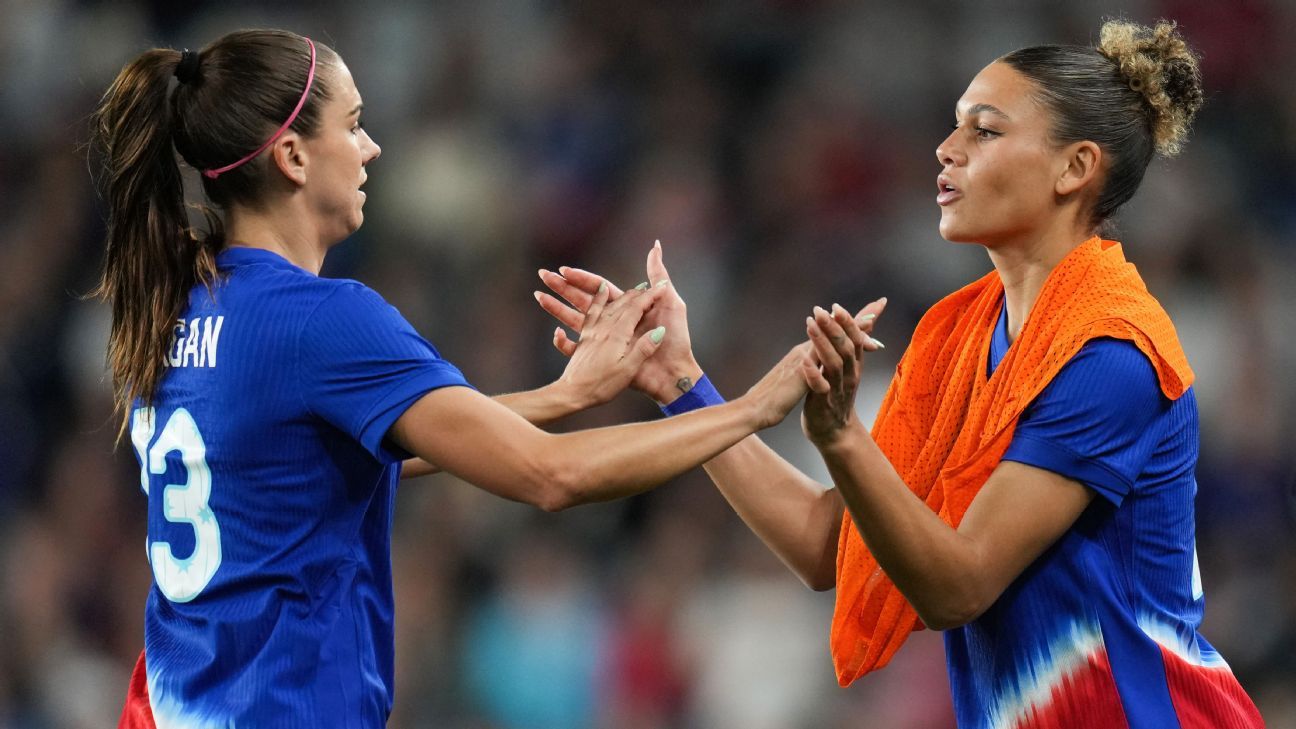The US Women’s National Team (USWNT) has boasted a rich history of talented leaders and famous athletes over its 40 years. Notably, 14 players from various generations have surpassed 200 caps. However, the current team appears to be marked by a youthful inexperience as head coach Emma Hayes experiments with her squad leading up to the 2027 World Cup.
In a recent match against Brazil, Hayes fielded the youngest USWNT lineup in over two decades and has issued 23 first-time call-ups since her appointment in November 2023. Currently, 15 players on the roster have fewer than 10 caps, including three goalkeepers who have accumulated a mere four caps collectively.
This generational shift highlights a significant moment in USWNT history, as there hasn’t been a definitive face representing the team or a spokesperson for its broader community. In recent years, Alex Morgan, Megan Rapinoe, and Becky Sauerbrunn have been the standout leaders, guiding the team to two consecutive World Cup titles and championing the fight for equal pay. All three players have retired in the past year and a half.
While transitioning between generations is essential for any team, it holds particular significance here, given the USWNT’s remarkable achievements, which include four World Cup victories and five Olympic gold medals. The current group must now contend with taking the mantle left behind by their predecessors, a challenge that feels unprecedented.
“We all understand the expectations for US national team players,” said Hayes recently. “However, we have many new players lacking in experience, and it’s crucial we develop them correctly.”
Last year, it was apparent that the transition within the USWNT was progressing well. After taking over in late May, Hayes led the team to win the Olympic gold medal by mid-August. At that time, her focus remained short-term, prioritizing immediate success over long-term strategies, but in the past eight months, she has begun to outline her vision for the future.
During the SheBelieves Cup in February, Hayes met with players like Lindsay Horan, Crystal Dunn, Emily Sonnett, Lindsey Horan, Tiana Davidson, and Sam Coffey to discuss her leadership style and how to pass on the team’s strong work ethics and values—what she calls “American DNA”—to a new generation of players forging their own identities.
“Their insights are essential for this process, and I value learning from them,” Hayes stated about her more seasoned players. “I might be a bit out of my depth right now, but I’m confident we’ll find our way forward.”
1:33
Labonta: USWNT Senior Call Up “More than 20 Years of Dreams”
Kansas City Captain Loila Bontta responds to her first senior call-up at the age of 32.
Horan, the current captain with 165 caps, is a passionate leader who often organizes the team behind the scenes, as Hayes noted after their Olympic win last August. She serves as a vital link between past and present players, having joined right before the 2016 Olympics and been part of the 2019 World Cup team. Only two other players from that 2019 squad remain on the current roster: Sonnett and Dunn.
Recently, Hayes announced Naomi Girma as vice captain. Both Girma and Horan have stepped into more vocal roles within the team.
“It’s going to take time,” said Sauerbrunn to ESPN. “Transitions took time after stars like Abby Wambach and Shannon Box retired post-2015 World Cup.”
“Being open to learning from previous leaders is important, and once you feel comfortable, it’s essential to establish your own voice within the team,” she added.
Nonetheless, the USWNT is in a unique position as the most renowned women’s sports team in history, boasting incredible success in women’s soccer.
The Sauerbrunn generation has faced challenges, both against the US Soccer Federation and politically during Trump’s presidency. She hopes the next generation can avoid similar burdens but acknowledges that’s often not an option due to the responsibilities associated with playing for the national team.
“This platform carries responsibility,” Sauerbrunn explained, emphasizing that the team must navigate these expectations, whether they invite that level of visibility or not.
With 33 caps, Sam Coffey, captain of the Portland Thorns, is among the rising leaders of the USWNT. She mentioned that leadership roles evolve daily, underscoring how vital engagement is, particularly when the team goes quiet.
Though Coffey has not played extensively with earlier stars, she has earned recognition as the “gold standard” for leadership from her teammates, including Sauerbrunn.
In recent World Cup cycles, Sauerbrunn has frequently served as captain. Alongside her were Rapinoe and Morgan, who became global icons of the team, while the likes of Wambach and Mia Hamm fulfilled similar roles in their time.
24-year-old Girma, already vice captain, is marked as a key leader for the future. Yet, due to injuries and absences, she has missed several training camps. Additionally, Davidson, Rodman, Swanson, and other core players have been sidelined due to various reasons, including injuries and maternity leave.
Despite these challenges, Rodman has emerged as a star with a strong cultural presence, appealing to audiences beyond sports. “Given that she’s becoming a prominent figure, it’s likely she’ll take on a leadership role,” said Sauerbrunn.
Rodman electrifies fans with her performance, and the media’s attention on her suggests she might be the face of the USWNT moving forward. Managing her health will be crucial, as she expressed concerns about her ongoing back issues.
There’s an argument to be made that Hayes stands as the team’s most prominent figure, shaping the current dynamic of the player base. Winning her first Barondoor Coaching Award last year, she effortlessly garners attention wherever she goes, whether in a team meeting or a packed conference.
Hayes seems to use her position to lessen the external pressures on this young team, including stars like Rodman and 17-year-old midfielder Lily Johannes, emphasizing the need for patience during this transitional phase.
“We’re witnessing this inexperienced team develop,” Hayes noted after their 2-1 victory over Brazil on April 5th.
The question remains: Who among these players will emerge as the next prominent face of the USWNT? This uncertainty is a new and potentially uncomfortable position for the team, but it is also a necessary part of their evolution.
Fan Take: This transition within the USWNT is crucial for soccer fans, as it marks the beginning of a new chapter for one of the sport’s most iconic teams. The success of these young players could redefine the landscape of women’s soccer and inspire future generations.



